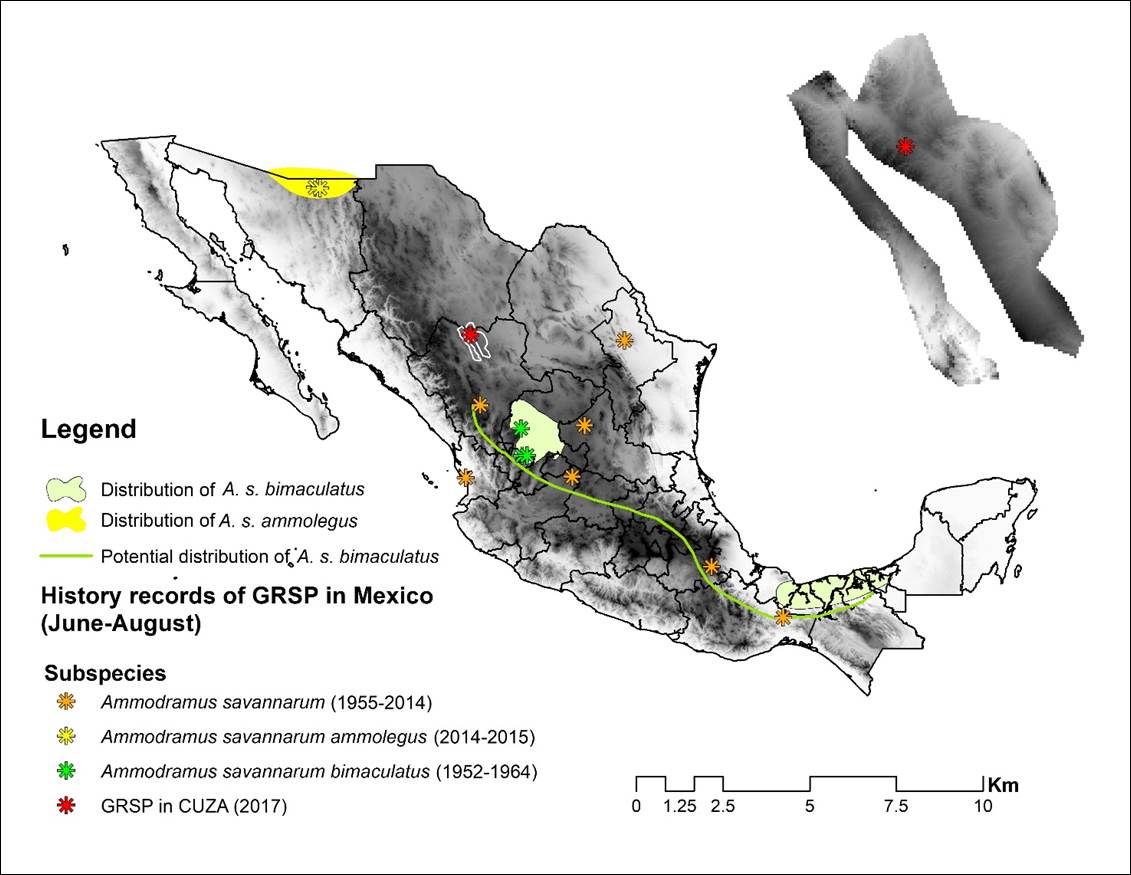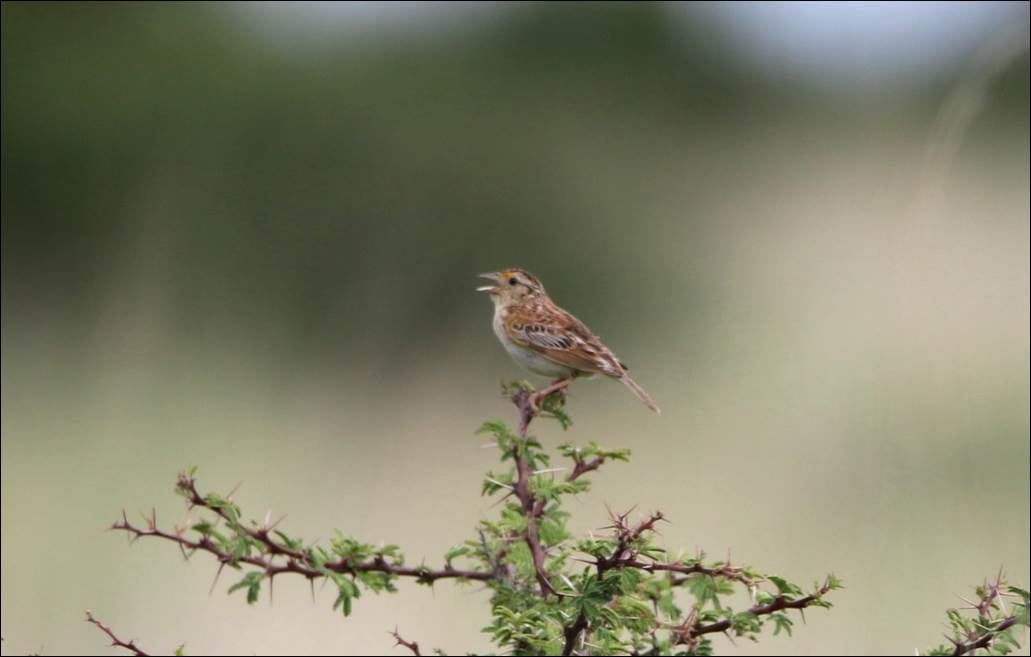Introduction
In the USA, grasshopper sparrow (Ammodramus savannarum) is a species of conservation concern as its populations have been decreasing significantly, as well as the populations of other grassland bird species (Sauer et al. 2017). Human activity has caused the fragmentation and degradation of the habitat of this species in both the breeding and wintering areas (White et al., 2000, Pool et al., 2014).
Twelve subspecies have been described for the Americas (Vickery 1996, Ruth 2015), four of them breeding in the grasslands and prairies of North America. An eastern subspecies (A. s. pratensis) breeds from west-central Canada southward to east-central USA, and a western subspecies (A. s. perpallidus) breeds from southern British Columbia, Canada, southward to southwestern California, central Nevada, Colorado, and Texas in the USA (Vickery 1996, Savignac et al. 2011). A southwestern subspecies (A. s. ammolegus) breeds in southeastern Arizona, southwestern New Mexico, south to northern Sonora, and winters in western Mexico (Ruth 2008). A non-migratory subspecies (A. s. floridanus) breeds and winters in Florida (Vickery 1996). All these subspecies can be discriminated on morphological grounds (Ruth 2017) but not by molecular markers. However, in a genetic study, only the Florida (A. savannarum floridanus) subspecies showed signals of genetic structure and unique haplotypes compared to the eastern (A. savannarum pratensis) and southwestern (A. savannarum ammolegus) subspecies (Bulgin et al. 2003). They did not include samples of the western subspecies (A. savannarum perpallidus).
Concerning the migratory status of grasshopper sparrow (Vickery 1996) found that the populations of both the western and eastern subspecies are highly migratory, the southwestern subspecies is partially migratory in the Florida, Caribbean and Central America subspecies are residents and can make local movements. Some of the migratory populations of North America spend their wintering season in southwestern USA and northern Mexico, but there is uncertainty between the connections between breeding and wintering sites (Vickery 1996, Ruth 2015). In general, grasshopper sparrow occurs in highest density throughout the western edge of the Grasslands Priority Conservation areas (GPCA) of the Chihuahuan Desert, from Sonoita (65.17 birds km2) and Sulfur Springs (70.34 bird km2) south through Janos (47.7 birds km2) and Valles Centrales (33.54 birds km2), Alto Conchos (52.32 birds km2), Cuchillas de la Zarca (73.14 birds km2) and Malpaís (72.27 birds km2), with these last three GPCAs harboring 54% of the total winter population in the Chihuahuan Desert Grassland Priority Conservation Areas (CEC, 2013).
In northern Mexico there is only one breeding record of grasshopper sparrow (GRSP) in the grasslands of the state of Zacatecas that dates back to the mid-1950’s. However, GRSP has not been recorded recently during the breeding season. So, The purpose of this communication is to report the first confirmed breeding record of grasshopper sparrow for the state of Durango at the GPCA of Cuchillas de la Zarca, and to describe its breeding habitat in order to propose conservation strategies that will allow to maintain and if possible, improve grassland habitat, benefiting not only the wildlife that depends on this ecosystem, but also the landowners through better grazing systems.
Methods
Study site
From July to September 2017, we surveyed the grasslands of adjacent states of Durango and Zacatecas searching for breeding activity of grasshopper sparrow, looking especially at the locality where A. s. bimaculatus was recorded by Webster and Orr (1954), the northern know locality for this subspecies, distributed southward through Mexico to Central America (Vickery 1996). We found that the habitat at this locality has been wiped out by overgrazing and converted to croplands and, consequently, no activity of grasshopper sparrow. In this regard, we conducted a search of historical information collections of specimens, records and observations through various banks of scientific information and citizen science, by consulting websites for A. savannarum in Mexico, making a filter with dates where the species could be in reproductive status (June-August), which generated a map of historical records of this species, to observe according to those records which subspecies of A. savannarum is closest to our finding (Figure 1).

Figure 1 History records of Grasshopper Sparrow in Mexico (June to August). Data of https://www.gbif.org/, Ornis.org, https://ebird.org/home.
In our search, we surveyed the wintering habitat that we have been studied since 2007 at CUZA (CEC and TNC 2005) and we found positive evidence of their presence as singing males responded to our song broadcasting. CUZA is located between 26º20’11.24” and 26º17’5.98” N latitude, and 105º10’58.11” and 105º9’15.35” W longitude, and a mean elevation of 1,850 in Durango State.
Vegetation structure
In a 109-ha patch of grassland we determined plant species composition by walking through the patch and recording dominance and co-dominance of grass and shrub species.
Bird surveys
We used a grasshopper sparrow recording from Merlin Bird ID (Cornell Lab of Ornithology) for Android®, the record of song and calls were from singing males of California, and North Dakota U.S.A., to elicit bird song and bring them into view as we walked linear transects throughout the patch and every 150 m we did a point count (Bibby 1992). We registered: individual number, the perch site for singing with a Garmin eTrex® GPS navigator, the type of perch and the composition of the vegetation surrounding the perch, also some pictures were taken with a CANON® camera 7D mark II, and a SIGMA® 150-600 mm, telephoto.
Results
Vegetation composition
The shrub stratum is composed mostly of large to medium shrubs, such as huizaches (Acacia schaffneri), mesquites (Prosopis glandulosa), Mormon tea (Ephedra trifurca), junipers (Juniperus coahuilensis) and prickly-pears (Opuntia spp.), and abundantly, the small brickellbush (Brickellia spinulosa). The herbaceous layer is composed mostly of grasses with species such as Bouteloa gracilis, B. curtipendula, Panicum obtusum, Lycurus pheloides, Chloris virgata, C.submutica, Aristida adscensionis, A. divaricata, Bothriochloa barbinoidis, Mulhenbergia emersleyi, and Pleuraphis mutica. It is worth noting that we did not find any cattle grazing on the patch nor signs of recent grazing.
Bird surveys
On August 18th, 2017 we recorded six grasshopper sparrows in the patch of grassland described above. Two males answered very quickly to the broadcasted song and perched in huizaches and junipers taller than 1.70 m. (Figure 2). We observed birds displayed territorial behavior, some pursuits and mid-air fights between the males, and that was considered as evidence of breeding activity.

Figure 2 Grasshopper Sparrow (Ammodramus savannarum) singing male at North of Durango, summer 2017 (photo: Jose Hugo Martínez).
On September 1th, we located a nest of A. savannarum, by behavior of grasshopper sparrow female, that flying around the nest and sometimes carrying food for 4 chicks; the nest (Figure 3), was located at the base of bunchgrass Bothriochloa barbinoidis (Cane bluesteam), confirming with it the first documented breeding record in the state of Durango during summer.
Discussion
The breeding range of grasshopper sparrow is poorly documented for northern Mexico and Central America (Howell and Webb 1995), except for old record of Webster and Orr (1954) in Zacatecas at Laguna Valderrama. However, Slater (2004) mentions that breeding populations may exist along the Gulf of Mexico coast, Belize, Costa Rica, and Panama. A very dubious record of breeding activity from the Chihuahuan Desert was reported from bird surveys in spring and summer (Manzano-Fisher et al. 1999) but presence does not imply breeding if no nest or fledglings are recorded.
After searching for records in collections of museums and information banks on the web, we found that for Mexico in the months in which Ammodramus savannarum is commonly in reproductive stage (June-August), it has been registered 24 times, between 1952 and 2014. Of the total of records 13 correspond to collection of individuals for museums, subspecies A. s. bimaculatus between 1952 and 1964 in the states of Zacatecas and Jalisco (Vertnet 2016), the rest (11) including two individuals collected in Durango, do not specify which sub-species they belong to (GBIF 2019), and the most recent are observations made by bird watchers that make their listings public on the eBird website (eBird, 2019).
As we found breeding activity (active nest), this is the first documented breeding record of grasshopper sparrow in northern Mexico, particularly in the grasslands on northwestern Durango, supporting Ruth’s claim (2015) about its unknown distribution in Mexico (Figure 3)
The simple analysis of the historic information reviewed suggests that it is possible that the birds we found in the north of Durango belong to the sub species A. s. bimaculatus because the distance of the records found is closer than for the distribution range of A. s. ammolegus, north of Sonora, Mexico.
At the same time we consider important, describe the registered individuals that showed a marked reddish coloration on the back (Oberholser, 1942), and the face with less pale appearance in comparison with the wintering birds (Figure 2) additionally, the geographical area of this finding and the characteristics of the habitat (Howell and Webb, 1995; Ruth, 2015), suggest that it may be Arizona grasshopper sparrows (A. s. ammolegus), but this will be clarified through the genetic analysis and motive of another investigation in this subject.
The response to singing of individuals to a record of A. s. perpallidus, suggests that this species may not have variants in the song between the different North American sub species. The breeding season of grasshopper sparrow does not start synchronically due to latitudinal differences, as it is well known that breeding starts earlier at higher latitudes because of the snow effect, whereas in more southern latitudes it starts later as it is more dependent of summer rain (Jones et al. 2010, Ruth 2017), the date of our breeding record in the grasslands of Durango at CUZA supports these statements.
The nesting habitat in the northern Great Plains is described as open grasslands with bare ground and some bushes (Herkert 1994, Vickery 1996, Block and Morrison 2010). However, in southeastern Arizona (Ruth 2015) the species nests in more open arid grasslands, compared to the grasslands of the Great Plains, but still with a high grass cover, a low area of bare ground, and low to medium shrub cover. At our study site, the grassland has all these features, supporting again Ruth’s findings. It should be noticed that no grazing activity was observed, a factor that has a negative effect on the nesting of grasshopper sparrow (Sutter and Ritchison 2005). These conditions were also favorable for other species of grassland birds to have reproductive success such as eastern meadowlark (Sturnella magna), Cassin’s sparrow (Peucaea cassinii), canyon towhee (Melozone fusca) and white-tailed kite (Elanus leucurus) of which we also found active nests.
Conclusions
We documented the first summer record of grasshopper sparrow in the northwestern grasslands of Durango at the GPCA of CUZA. Evidence of breeding activity was based on eliciting male song and finding the nest with nestlings and the description of vegetation structure as breeding habitat are a contribution to the knowledge of the biology of grassland birds in northern Mexico outside the wintering season.
Our finding confirms the importance of Grasslands Priority Conservation Area of Cuchillas de la Zarca as a wintering and breeding site for the different grassland birds, mainly for species that decrease in their population size as Ammodramus savannarum.











 nova página do texto(beta)
nova página do texto(beta)




